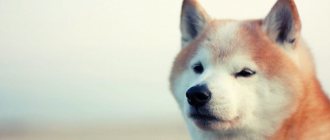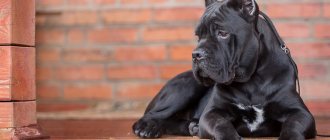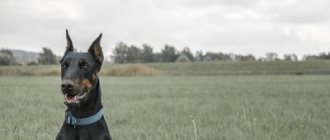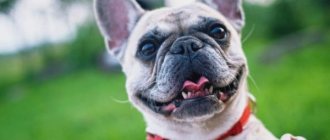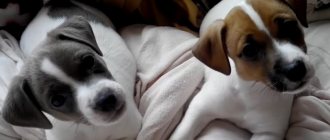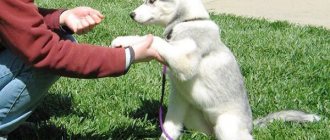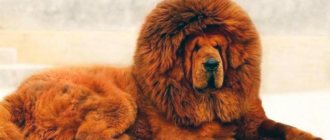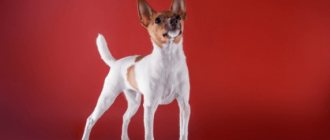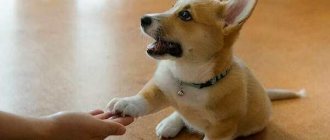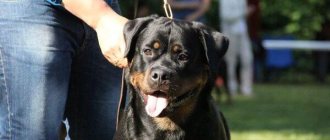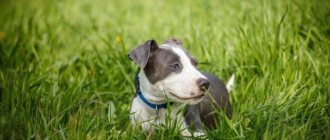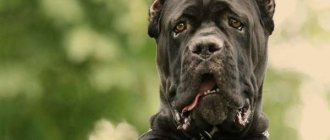You have become the proud owner of an American Akita puppy. Let's take a closer look at what age and where to start training your new pet. Let's consider at what age what to focus on in education and training. Let's not forget about socializing the dog on the street and with other dogs. We will also compare independent classes and classes with a dog handler (in a group and individually).
|
Basic moments
- Excellent watchdog qualities are the calling card of the American Akita. With such reliable security, you can feel calm and safe.
- By remaining faithful to the owner and recognizing his leadership, the Akita can try to dominate him. Attacks of “arrogance” most often occur during puberty.
- With proper upbringing, a representative of this breed can be molded not only into an excellent companion, but also into a hunter, guide or guard.
- The American Akita has a very stable psyche. She only shows aggression when there is danger.
- Training a breed is not easy work. The dog is extremely intelligent and unquestioningly obeys its owner only if it considers him the unconditional leader.
- The American Akita is a well-mannered dog and easily tolerates visual contact. However, if you look into her eyes, it is not recommended to bend over: she may perceive this as aggression towards herself.
- The breed does not tolerate long separation from its owner. Loneliness can trigger behavioral problems and become a source of great stress.
- Despite its open and sociable character, the Akita is quite cold with strangers until it decides for itself whether it can trust this or that person.
Mating
Before breeding an American Akita, the female must be prepared. First of all, get vaccinated. Manipulations are carried out 1 month before the planned estrus. Vaccination will strengthen the dog’s immunity and eliminate the risk of complications.
If vaccinations are not necessary, then be sure to give an anthelmintic to prevent parasites. Anti-tick and flea medications are allowed to be used no later than 2 weeks before mating.
Mating is carried out 2 times to ensure fertilization.
Ideally, 2-3 weeks before the heat, the dogs should be introduced and walked together. When the time comes for mating, the female will behave more favorably towards her partner.
Note! It is important to choose a secluded place, without other animals and people who might disturb your pets
History of the American Akita
The word "American" in the breed's name can be confusing when it comes to its origins.
The second name - large Japanese dog - is more eloquent in this regard: its homeland is the Land of the Rising Sun. But how did it happen that the Akita suddenly became American? The ancestors of the American Akita are the Japanese Akita Inu, which were originally used for hunting and guard purposes. Several centuries ago they were called differently: Matagi-Akita. Later they began to be used in dog fighting, which became especially popular at the turn of the 19th and 20th centuries. In pursuit of monetary gain, owners sought to “improve” their dogs, making them larger and stronger. For this purpose, they were crossed with breeds brought to the islands such as mastiffs and shepherd dogs.
However, as a result of these manipulations, the classic features of the breed began to blur, deteriorate, or even be completely lost. The damage caused to the Matagi Akita was noticed at a dog show held in Tokyo in 1914. Soon, pure representatives of the breed were declared natural monuments, and their crossing with representatives of other species was strictly prohibited. The breeders had more work to do: they did everything possible to return the Matagi Akita to its original characteristics.
Before these magnificent dogs, which became the source of national pride for the Japanese, had time to recover from the blow inflicted on the breed by irrepressible human greed, World War II broke out. By order of the government, all breeders donated their pets to the needs of the front. As is known, the end of the war was marked by the surrender of Japan in 1945. Returning to their homeland, US military personnel decided to take with them several puppies they liked. It was they who became, a few years later, the progenitors of a new breed. But the actual classic Akita Inu remained on the Japanese Islands after the war, no more than 20 individuals.
At the same time, overseas the breed began to gain widespread recognition and developed at a rapid pace. At first it was called a large Japanese dog. But in the States, work on the breed was not synchronized with the Japanese - it proceeded in parallel and, as they say, on its own path. Japanese breeders tried to negotiate with their American colleagues regarding her common pedigree, but in vain. They did not even allow dogs declared natural monuments on the islands to be exported to the United States. All these measures did not stop the Americans. As a result, over time, the overseas Akita began to differ from the Japanese one in both appearance and character. And then it received a new name - American Akita.
In 1956, a club for the newly formed breed was created, recognized by the American Kennel Club only in 1972. The “breed war” with Japan continued until 1992: for two decades, the kennel clubs of both countries did not recognize each other - only the Japanese Akita Inu was registered with the Fédération Cynologique Internationale (FCI). The official division of the breeds occurred only in 2000, when the FCI approved the standard for the overseas Akita.
Features of the American Akita
The American Akita is an excellent hunter. If you suppress this natural quality in a dog, it will still manifest itself in one way or another, and not in the most pleasant way for the owner. For example, on a walk your pet will begin to rush at smaller dogs or “bully” the cat living in the same house.
The American Akita is also called a one-owner dog. She has a very hard time with a change of owner and often cannot adapt to living in another place for the rest of her life. A classic example is the famous Hachiko, an Akita Inu dog, who gained fame throughout Japan in 1932 after the publication in one of the largest Tokyo newspapers of the article “A devoted old dog awaits the return of his owner, who died seven years ago.” Based on this story, which touched the hearts of millions of people around the world, a film was made in 2009 with Richard Gere in the title role.
As you can see, the American Akita inherited this quality from its Japanese counterparts - devotion. It will be especially difficult to find common ground with an adult dog for those new owners who have not previously had experience communicating with large Molossians.
What can be taught?
By correctly and consistently carrying out all the steps to raise and train a pet, an Akita dog can be taught everything that other trained dogs can do.
First of all, the puppy must be accustomed to the important components of life with a person :
- use a diaper to relieve yourself;
- do not bite a person;
- do not be afraid of the collar and leash;
- do not beg for food from the owner’s table or pick it up from the floor;
- treat strangers with respect;
- stop barking on the owner's command;
- follow basic commands “sit”, “stand”, “lie down”;
- understand the command “fu”;
- execute the "nearby" command.
NOTE!
Learning certain behaviors and commands occurs gradually; you cannot throw everything at once onto the puppy’s fragile psyche and body.
Appearance of the breed
The American Akita is a very large dog. Strength and power can be read in her every movement. Gradually, the hunting skills of these dogs are becoming a thing of the past, which is largely due to their large size, which prevents the overseas “Japanese” from remaining fast and agile hunters.
Thanks to its special appearance features, namely its spectacular color and perfect lines, the American Akita has long been “registered” at dog shows in different countries of the world, including Russia. Representatives of the breed often lead in BESTS of the fifth group, often winning entire competitions.
general description
It is very difficult to confuse an American Akita with another breed - it is almost impossible, even if before “personal acquaintance” you had only seen it in a photo. The first thing that will catch your eye, in addition to its impressive size, is its strong body with well-developed muscles and massive bones. The “bear” type muzzle with small eyes and a relatively short bridge of the nose will definitely attract attention.
The height and weight of the American Akita, as well as the proportions of the body, vary depending on gender. The height of males at the withers varies from 66 to 71 cm, females - from 61 to 66 cm. The weight of adults is usually: males 45-65 kg, females 32-45 kg.
For males, the ratio of the height at the withers to the length of the body is 9:10, for females it is 9:11. The distance from the foot to the tip of the nose correlates with the distance from the foot to the occipital protuberance in a ratio of 2:3.
Head
The head is the hallmark of the breed. Massive, but at the same time in harmony with the body. There are no skin folds (wrinkles) - provided that your pet is in a calm state. When viewed from above, the shape of the head resembles an obtuse triangle.
The skull is wide and flat, with a shallow groove running upward along the forehead. The transition from forehead to nose (stop) is well expressed, but not sharp.
Wide and voluminous muzzle with powerful, square-shaped jaws. The suspension of the jaws is light. The ratio of muzzle length to skull length is 2:3.
Teeth
The bite is characterized as a regular scissor bite. However, the breed standard also allows for a straight bite. The teeth are strong, the dental formula must be completely present.
Eyes
The Akita's eyes are small, almost triangular in shape, and deep-set relative to the size of the head. Color – dark brown. The eyelids are black and fit tightly.
Ears
The ears are also small in relation to the rest of the head. Standing, triangular in shape. They have a wide base on strong cartilage, slightly rounded at the ends. The setting is not too low. Above the eyes, at the level of the scruff of the neck, slightly tilted forward.
When pulling the ear forward, its tip should ideally touch the edge of the upper eyelid. If you look at the Akita's ears from the side, they seem to continue the top line of the neck.
Nose and lips
The nose is black, wide, the nostrils are well open. Liver color is allowed, but only the American Akita is white. Although it is still preferable to “classic” the breed, that is, the black color of the nose.
The lips are also black, dry, and fit tightly. The tongue is pink.
Neck
Massive, thick and relatively short, with minimal dewlap. Muscular, widening towards the shoulders. The scruff has a good convexity, smoothly passes into the base of the skull and merges with it.
Frame
The body length of the American Akita exceeds the height of the dog at the withers. The chest is wide, voluminous and deep.
The depth of the chest is equal to half the height of the animal at the withers. The ribs are distinguished by sufficient convexity (arched).
The belly is moderately tucked. The back is straight, the lower back is muscular and strong, with a slight convexity. The skin is elastic and fits tightly.
Tail
Covered with straight, thick and coarse hair, it does not form a dewlap. Its base is large and powerful. The tail is set high and the Akita carries it over its back. Or, as an option, the tail touches the side. The tip must reach the back or fall below its level.
The tail is bent into a ring, sometimes double, forming three-quarters of a circle. The last vertebra, when fully rotated, reaches the hock joints.
Limbs
The forelimbs have powerful bones and look straight when viewed from the side. Shoulders moderately sloping back, strong and firm. Elbows should look strictly back, not turned outward or inward. The pasterns have a slight slope, about 15 degrees to the vertical. The paws are round in shape, “cat” type, the direction is straight. The pads are thick and elastic, the fingers are arched with strong claws.
The hind limbs are also distinguished by strong bones and powerful muscles. Hips are well developed and strong. The metatarsals have a fairly low location and are not turned outward or inward. The knee joints, when viewed from behind, are parallel and characterized by moderately pronounced angles. Paws are straight-directed, with elastic pads, round ("cat" type). The fingers are convex (arched) and equipped with strong claws. The so-called dewclaws, that is, the fifth in a row, are usually removed.
The American Akita's gait is characterized by strong, free movements. They are also distinguished by a moderate lunge and push. The movement of the front and hind limbs is carried out in the same plane.
Wool
The coat is double and has a dense undercoat. The guard coat is coarse and straight, while the undercoat is soft and dense and somewhat shorter in comparison with the outer coat.
The hair on the head, ears and limbs is short. Its length at the rump and withers is approximately 5 cm, which is slightly longer than on other parts of the body, with the exception of the tail. It has the longest and most abundant fur – over 6 cm.
Color
The breed standard here is very democratic, allowing any color options, including white, fawn-white, red and brindle. American Akitas can even be piebald, that is, spotted (pinto) - with or without a mask. Instead of a mask, there may be a spot on the forehead or a dent on the muzzle. The mask is completely eliminated only in white individuals. White individuals have black lips, nose and pads.
The colors of dogs of this breed are clear and pure. The spots have clear contours and are evenly spaced. In the Pinto, the spots on a white background are evenly distributed, covering the head and more than one third of the dog's body; a dark-colored mask is allowed.
The color of the undercoat may differ from the coat color.
Possible defects
- Absence of any tooth, with the exception of 2 PM-1 and/or M3.
- Short tail.
- Light eyes.
- Males of the bitch type and, accordingly, bitches of the male type.
- The tongue is blue or with black spots.
- The presence of a collar or fringes.
- Turning of the elbows (inward or outward).
- Anger or, conversely, timidity.
- Lightweight frame.
- Insufficient body weight.
Disqualifying faults
- Partially or completely absent pigmentation of the nose (the so-called butterfly nose).
- Overshot or undershot.
- Semi-erect or completely drooping ears, with folds.
- The tail is straight or crescent shaped.
- The height of males at the withers is less than 63.5 centimeters, and that of females is less than 58 cm.
- Aggression or cowardice.
Any obvious physical abnormalities or problematic behavior is grounds for disqualification of the American Akita.
!!!! Please note: male dogs must have two healthy, developed testes, fully descended into the scrotum.
Description
When reading descriptions of a Chinook, do not forget that this is a working dog and was bred specifically to work in the harsh North.
The dog has an athletic build. She has excellent flexibility. It's perfectly balanced. More similar to a retriever than to the northern breeds: huskies or Spitz. There is currently no officially approved standard for Chinooks.
At the withers the animal is from 53 to 68 cm.
- Pets weigh up to 42 kg.
- The Chinook's coat can be light golden, golden fawn, or honey. It is good when there are dark-colored markings on the ears, muzzle and tail.
- This breed of dog does not have a fluffy collar or pants, like Spitz and Laika. Their coat is medium in length, lying close to the body. It will be a little longer on the neck and lower down to the chest. The dogs have a thick undercoat with a red tint.
- Chinooks have drooping ears, while most sled dogs have erect ears.
- Males are slightly larger than females, and when there are 3 or more dogs of different sexes nearby, you can understand where the males and females are?
Performance evaluation and information
The first thing that catches your eye is the size of the Chinook:
- height at the withers - 60-68 cm;
- weight - 37-46 kg;
Such parameters became a necessity, because the breed was bred as a sled dog. To achieve this, she has a powerful neck, a straight, muscular back and strong paws. A predisposition to hard work is also indicated by the developed muscles of the shoulder girdle and chest. The Chinook is an athletic, flexible, balanced breed that differs radically from its famous colleagues, the huskies, in its smooth movements and grace.
Since 2009, the Chinook has been recognized as the state symbol of New Hampshire in the United States. But despite their “workhorse” status, these dogs are very beautiful. Their fur shimmers in all shades of gold: from light honey to orange-red, creating the impression of warmth and comfort. It is not thick or long, but fits well to the body, warming it. The undercoat is dense and has a reddish tint.
If you look closely, you can see white areas on the chiseled cheekbones, taut stomach or toes. But black spots appear on the ears, face, and tail. This jet black eyeliner accentuates the eyes. The Chinook's head is round, slightly tapering towards the black nose. The floppy ears of medium length are another difference from typical northern breeds. This structure of the muzzle provides them with acute hearing and a developed sense of smell.
Today, there is no official standard for the breed due to its small numbers, but its representatives win sympathy from the first meeting, so it is quite possible that the population will soon recover.
Pros and cons of the breed
Like any other breed, the Chinook has its own advantages that set it apart from other animals.
He is considered a good friend because he is characterized by special devotion and love for his owner. Dogs of this breed become very attached to people and retain this attitude throughout their lives.
These animals are very hardy and strong, they can easily tolerate cold.
Chinook is able to navigate well in difficult conditions, assess the current situation and make the right decisions, which indicates his extremely sharp mind.
The breed is characterized by a lack of aggression; the animal can only use it as a defense.
Dogs are kind and friendly. They easily establish contacts with children and other pets.
The dog is brave and can protect itself and its owner.
The disadvantages of this breed include its rather late maturation. Fully mature dogs are capable of fooling around and chasing cats like puppies.
Number
Now the breed is recognized as the rarest in the whole world, but even when its representatives were at the peak of their popularity, their number was no more than three hundred individuals.
And in 1966 it fell to 125, in 1978 – to 28.
Role for the US
Thanks to the clubs that began to protect these dogs, they still exist. But this breed was not recognized by any cynological organization due to their small numbers.
In 2009, representatives of the breed became the new symbol of the state of New Hampshire in the USA.
Read with this
Character of the American Akita
The American Akita is distinguished by its independent and freedom-loving disposition. But at the same time, this is a calm dog, affectionate, balanced. Thanks to her mature, stable psyche, she behaves with dignity and shows restraint in any situation.
Representatives of the breed never have causeless reactions to external stimuli. She does not bark over trifles, and without good reason she does not rush at anything that moves, just because it moves. Akita - smart, reserved, well-mannered and noble - such behavior is completely unusual.
If you keep your pet in an ordinary city apartment, you don’t have to worry that the American Akita will cause any inconvenience to your neighbors. There will certainly be no complaints about constant barking and howling. But if an Akita starts to vocalize, you can rest assured that there is a good reason for it! The barking of your pet is a sure signal that an ill-wisher has encroached on your territory or your property.
Dogs of this breed, like real samurai, love to keep everything under their control - apparently, this is how the genes inherited from their Japanese ancestors manifest themselves. This quality in the American Akita can be called one of the fundamental, because it helps her in fulfilling the mission inherent in nature - to be an excellent watchman. Take a closer look at your dog when he surveys his possessions: there is something bewitching in his gaze, inaccessible to human understanding.
The American Akita is distinguished by its boundless devotion to its owner and his family members. Like the Cane Corso, she gets along very well with children, often even looking after them like a nanny. But, unlike the “Italian,” our “American” cannot be trusted with children who are too young. Not at all because he is capable of offending them. On the contrary, when he feels threatened, he will, without hesitation, rush to protect the little household members. An Akita cannot be a full-fledged nanny due to its size. Leaving the baby alone with her, you cannot be completely sure that the dog will not accidentally push him or cause him some kind of injury. For some of the younger family members, the Akita will become a true friend, especially for teenage children. They won't find a better companion in active games and various pranks!
At the same time, the breed is absolutely not characterized by such traits as obsessiveness and importunity. Although the Akita was specifically bred to live with humans, it still needs its own space. The “American” will never get in your way, but at the same time, you should not impose yourself on him again.
The peculiarities of the “inner world” of the breed also include intolerance to rudeness on the part of the owner and other household members. If an American Akita is yelled at or punished unfairly, she becomes very offended. Never raise your voice at your pet, do not offend him, and especially do not use physical punishment on him.
The American Akita feels great in a country house with a spacious yard. A large territory is her element: there is something to protect, and there is a place to feel like a master. When keeping a dog in an apartment, under no circumstances turn your pet into a “prisoner” of your square meters. A representative of this breed needs not only regular, but also long walks. Moreover, you need to walk him twice a day for at least 1-2 hours. Walking just “for show” is not suitable for Akita. They should be interesting, rich, active, with elements of play and training. All these points will help maintain the dog’s physical and mental health at the proper level.
The American Akita has a remarkable memory and trusts its owner, so it is very important not to deceive the dog, it does not like this and remembers such moments for the future. That is, if you, for example, lured her with a treat or gave the command “Eat!” or “Go for a walk!”, but didn’t do anything, then you risk losing your pet’s trust: he will stop perceiving you as his leader.
Quite often, a problem such as aggression towards other dogs arises in Akita behavior, which can cause some trouble for the owner. It is to dogs: she often shows loyalty to cats, but only to “her own” - there will simply be no strangers in the territory she controls. As for other people's dogs, adult Akitas, especially males, almost never accept other dogs into their company. On walks, they often show their character not from the best side, provoking quarrels and fights. From this we draw a simple conclusion: when you find yourself with your pet in dog walking areas, under no circumstances let him off the leash.
Training
The best training option for the breed is an active play form. You need to understand exactly what your pet wants. Dogs tolerate monotonous exercises especially poorly, including many hours of repetition of similar actions. The dog may quickly lose interest in the training and refuse to take part. You need to cheer up the animal, distract it.
You cannot use physical force on an Akita. The dog may become angry or offended by the owner. It is extremely difficult to regain the pet's affection and restore trust. A dog's ability to learn depends on his mood. If the animal does not show a desire to engage in new techniques, then it is advisable to postpone Akita training to the next day.
The training of the American Akita should begin at an early age. Puppies are sociable, so they should be allowed to interact with other animals. Otherwise, as dogs mature, they may show aggression towards their own kind.
The basic rule of training is contact with the pet. The dog must completely trust the owner. Treats that are rewarded for obedience will help cope with the stubborn nature of the animal.
The best option for training is to praise your pet for correctly following the command. Such dogs appreciate affection, but do not show it. Only the owner is allowed to train an Akita puppy.
Care and maintenance
Caring for an American Akita is not difficult, but it must be done. Hygiene procedures will help maintain your pet's health and beauty. In addition, daily care is the only way to promptly detect various diseases at an early stage and take the necessary measures.
The breed has a thick “fur coat” with a soft undercoat that is not prone to matting. The coat does not need cutting, but it needs to be washed regularly and combed with a metal comb 1-2 times a week. The coat is subject to shedding. The molting process is abundant, it occurs twice a year - in spring and autumn. During this period, the dog needs to be combed daily using a slicker brush or furminator.
Eyes need regular examination. If you notice small gray lumps in the corners of your eyes, you shouldn’t worry too much; they can be easily removed with a soft, lint-free cloth. If you notice excessive souring of the eyes, swelling of the eyelids, constant tearing, immediately contact a specialist. Self-medication in such cases is unacceptable.
The ears should be thoroughly examined once a week. In a healthy ear, there is no excess wax; it is a beautiful pink color. The reason for contacting a veterinarian should be an abundance of wax, redness of the ear and an unpleasant odor coming from it, as well as a rash. Only a specialist can determine what the reason is. And there can be many reasons: ear mites, otitis media, allergies to certain components of the diet.
Akita teeth need to be brushed 3-4 times a week using dog toothpaste. You can use a brush or just apply it to your finger. It is important to prevent the appearance of tartar, so the condition of the dog’s oral cavity should be constantly monitored, and you should regularly take your pet for examination to the veterinarian.
After walks, be sure to wipe your American Akita's paws using damp towels and inspect them for cracks and injuries. It is necessary to rub vegetable oil into the paw pads and include it in the diet, one teaspoon per day is enough. This simple preventive measure will prevent cracks from appearing. To trim nails (this should be done once a month), use a large breed nail clipper. To avoid chips and burrs, sharp ends are smoothed with a nail file.
What to feed?
There are no particular problems with organizing food for American Akitas. You just need to decide what kind of feeding the Akita will be (ready-made diets or natural feeding) and establish a diet. Adult dogs are usually fed twice a day, no earlier than 1.5 hours after a walk.
Puppy diet
Before feeding your Akita puppy, find out what kind of food he received from the breeder. After changing homes, he should receive exactly the same food. After a week, he can be switched to a different type of diet. The diet will depend on the type of constitution. Light, non-boned puppies are fed like other breeds. Large bony puppies require more attention to nutrition. This is due to the structural features of the pet’s skeleton. Babies need various mineral supplements with the addition of chondroitins and glucosamines for the full formation of the skeleton.
Feeding mode:
- 2 month old puppies – 5 times a day,
- 3–4 menstruation – 4 times,
- 4–12 months – 3 times,
- starting from one year - 2 times a day.
It is more convenient to use ready-made dry rations of at least premium class as feed. Cottage cheese, lactic acid products, fruits, and vegetables are added to them. For puppies, food can always be on the table, they have a sense of proportion, so the kids don’t overeat or overeat. And they practically never steal food from the table. Just keep in mind that you cannot give dry and natural food at the same time.
Adult dog diet
Most breeders feed the American Akita with ready-made food. “Natural food” takes too much time, and creating a balanced diet is quite difficult. The basic rule is to maintain a balance of substances. To do this, they use the formula: 50% meat and 25% vegetables and cereals, as well as vitamins and minerals.
Suitable cereals include buckwheat, rice, and oatmeal. Semolina, millet, and legumes are excluded from the menu. Meat – only lean (beef, veal, boneless poultry, offal). Adult dogs are not given milk because it is not digestible. Fermented milk products and cottage cheese are useful. Vegetables include carrots, beets, cabbage, raw or boiled. Many pets love apples, plums, and raspberries.
Dandelion leaves and greens can serve as a source of vitamins. Morksa cabbage and brewer's yeast work well. You should not give your pets lard, smoked meats, pasta, river fish (it is often infected with helminths), or sharp bones.
Health and Diseases of the American Akita
The American Akita is naturally endowed with good health and good immunity. Her puppies, unlike representatives of some other breeds, are less susceptible to infections. However, there are ailments to which representatives of this breed are genetically predisposed: hip dysplasia, progressive retinal atrophy, epilepsy, bloating, entropion and inversion of the eyelids, infertility.
Hip dysplasia can develop primarily due to excessive physical activity during growing up and due to poor nutrition. That is, despite the genetic predisposition, this disease may not develop if you provide the Akita with a balanced diet and do not overload it during training. Infertility in some dogs can be observed due to hormonal imbalances.
In addition, representatives of the breed may suffer from allergic reactions, seborrheic adenitis, hypothyroidism, dermatitis, gastric volvulus, pemphigus, intolerance to anesthesia, as well as Cushing's syndrome (also known as hyperadrenocorticism). This disease affects the organs of the endocrine system due to excessive production of adrenocorticotropic hormone by the pituitary gland and the hormone cortisol by the adrenal glands.
The average life expectancy of the American Akita is 10-14 years.
Tendency to diseases, vaccinations
Like other large breeds, the American Akita often suffers from joint-related diseases. This is dysplasia of the hip and elbow joints. American women may suffer from diseases of the eyes, heart, and thyroid gland, which are inherited. Responsible breeders exclude such dogs from breeding. Overall, this is a healthy breed with good immunity.
Vaccinations, anti-worming treatments
Only absolutely healthy dogs can be vaccinated. 10 days before vaccination, puppies are given an anthelmintic. Dosage - according to the instructions, strictly according to the weight of the pet. Subsequent dewormings are carried out monthly until 6 months of age, then every 4 months.
Approximate puppy vaccination schedule:
- 8 – 9 weeks – complex vaccination against plague, adenovirus, parainfluenza, parvovirus + against leptospirosis;
- 12 weeks – revaccination + rabies vaccination;
- 1 year and then annually - repeated revaccination + rabies vaccination.
How to choose a puppy
You should buy an American Akita puppy from trusted breeders who have been on the market for several years. It would be useful to find all possible information about the seller on the Internet and read reviews. An experienced breeder who values his reputation will definitely tell you which puppy is best for you. Some need a good hunter, others need a potential winner of all possible exhibitions, and others just need a good and faithful friend for themselves and their children, and to protect the house.
Be sure to look at the parents of the future pet. This is very important because the offspring inherits their appearance and behavior. If it turns out that the mother or father is cowardly or, conversely, aggressive, then the puppy you choose may very likely turn out to be the same.
Be sure to pay attention to the appearance of the American Akita puppy. He should have shiny fur that is soft to the touch. While petting such a puppy, an association with a plush toy involuntarily arises. If he is too thin, has a swollen tummy, red and watery eyes, or twisted elbows and knees, then it’s better not to take risks and don’t take it. You should not take a puppy that is too young in age, since professionals do not assign show classes to dogs under 9 months.
Your future pet should be active. Lethargy in behavior is a sign of depression, which in turn may indicate a particular disease. If possible, to rule out hidden illnesses that may manifest themselves in the future, pay attention to the puppy's feces. Its consistency and color may confuse you. In this case, you should refrain from purchasing.
How much does an American Akita cost?
The American Akita is not widespread in Russia. It is even less common than its Japanese counterpart, the Akita Inu. But in large cities you can find nurseries for breeding these majestic beauties. There is a direct relationship between the cost of a puppy and the class to which it belongs.
- A puppy without a pedigree is relatively inexpensive, from 10,000 to 12,000 rubles. However, such savings are associated with the risk of having a non-purebred Akita or, even worse, a pet with developmental defects.
- You can purchase a pet-class puppy, due to any deviations from the breed standard, not suitable for breeding, but healthy, for 15,000 rubles.
- From 20,000 to 30,000 rubles. There are puppies with a pedigree and permission to breed, but at the same time they do not have a chance to become winners of exhibitions due to some minor deviations.
- Well, if you have your sights set on a high-breed Akita, a future winner of exhibitions and the owner of a variety of titles, then choose a show-class puppy - a descendant of titled parents. Such a baby can cost 50,000 rubles, and this price is minimal.
By choosing the right pet for yourself, you can be sure that in the future you will become a strong tandem with him, doomed to successful interaction. And over time, as you grow older, your American Akita will turn into a full-fledged member of the family - obedient and devoted.
source www.lapkins.ru
